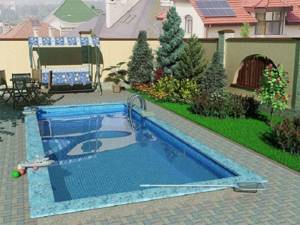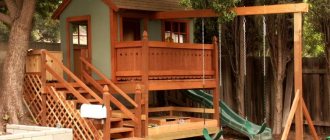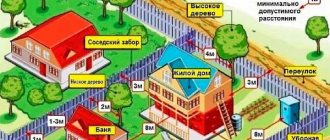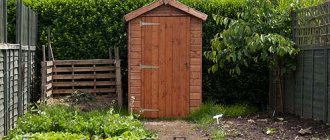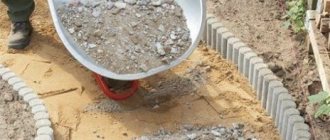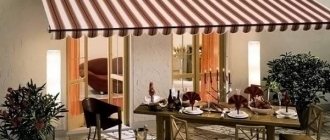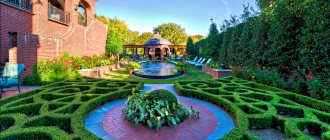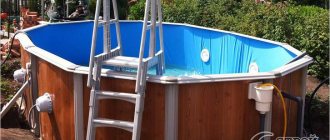A couple of decades ago, a swimming pool at a dacha was considered a curiosity and was evidence of the financial well-being of the owners of the site. The development of modern technologies helps to simplify the process of arranging an artificial reservoir in the open air. Designing a pool includes many stages, from choosing a shape to landscape design of the surrounding area. Familiarization with the nuances of design will help you competently approach the issue of arranging your own pool at the dacha.
Suburban area: a heavy burden or a place of rest
The mentality of the Soviet people, for whom the main purpose of the dacha was to grow vegetables and fruits, is gradually becoming a thing of the past. Nowadays they pay more attention to the landscape design of their summer cottage and take care of a comfortable pastime. A traditional bathhouse and a well-groomed lawn, a continuously blooming mixed border and an artificial pond are a classic set for complete relaxation.
A swimming pool at the dacha is not only an opportunity for children and adults to have fun, but also an excellent opportunity to improve the health of the body through moderate physical activity. The presence of large quantities of water on the site creates pleasant coolness on a hot day and improves the microclimate. Another advantage of having a swimming pool at your dacha is the presence of a reserve water tank, which can be used for irrigation in case of interruptions in the central water supply.
Depending on the size, you can organize the design of a swimming pool at your dacha yourself or seek the help of specialists.
Comment! A three-dimensional design will definitely require consultation from engineers and the supply of communications, otherwise amateur efforts will lead to disastrous results during operation.
Numerous innovative developments make it possible to select the optimal pool option for a dacha, depending on the age category of the main users, the size of the dacha plot and the financial capabilities of the owners.
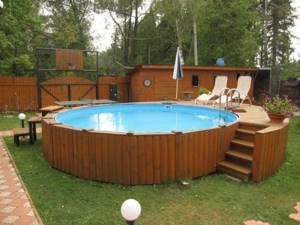
Artificial pond on the roof
In the modern world, exploited roofs are no longer something surprising: as you know, you can even build a parking lot or a helipad on them.
- But this is only if you design the building in advance and then build it in full accordance with the project. Loading a ceiling that is not designed for additional loads will only create an endless problem, which can be a pool on the roof of a house.
- Another thing is to use a flat roof (if a stationary artificial reservoir is not designed on it) to install a portable pool, which can be either inflatable or framed, covered with a waterproof polymer film.
It is quite possible to put a small frame pool on such a roof
- This is the cheapest and most acceptable option for private owners who decide to reconstruct the roof of a used house for the pleasure of splashing around in the pool in the summer.
- A stationary structure, no matter what some “experts” write on the Internet, must be designed without fail. And not after the construction of the building, but along with it!
In the photo - a built-in pool on the roof of the house
Note: Designing any hydraulic structure is always a rather complex and responsible matter; only a professional should do this. Any mistake can be fraught not only with financial losses, but also downright dangerous for the inhabitants of the house.
Even one cubic meter of water weighs almost a ton, and the smallest pool contains at least 5-6 m3. This is only water, but you also need to take into account the weight of building materials - and this is often solid brick and monolithic reinforced concrete, not counting waterproofing, cladding and the weight of engineering equipment.
So, talking about building a swimming pool on the roof of a private house yourself is simply pointless. But choosing a project if you want to build such a house is a completely different matter.
What types of pools are there?
In the designed building, the pool will be stationary and can be built-in or surface-mounted. The first version of the structure is built into the ceiling, placing the bowl in the room below. In the second case, the pool bath rests on the floor plane and is like a superstructure.
Note: Regardless of the design, the entire weight load falls on the walls (after all, the ceiling also rests on them), and they must be properly reinforced.
Swimming pool as a superstructure
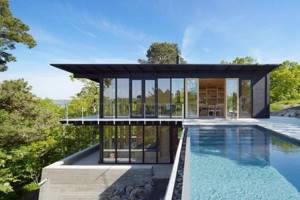
A stationary structure is not only labor-intensive, but also quite expensive in cost. It still makes sense where summer lasts most of the year, and the reservoir is constantly used. And even in the south in winter, this pool can be filled with snow. So for Russian latitudes, the best solution would be a temporary option, which is much easier to install and weighs much less.
This pool is not suitable for the Russian climate
The main thing in this case is that the ceiling is designed for additional load (mainly the weight of water, since the frame pool is very light), which can be discussed with the designer when purchasing the project. There are not many such projects, because such houses are not offered in the standard version, but they still exist. And we will consider one such project of a house with a rooftop pool below.
Types of outdoor pools
The process of designing an artificial reservoir begins with choosing a suitable design. Outdoor swimming pools fall into three main categories:
- stationary;
- collapsible;
- inflatable.
They all vary in shape, size, complexity of design and care. Each option has undeniable advantages and some negative points.
Stationary
The design of stationary models is appropriate for a spacious dacha; their arrangement is a one-time project and is characterized by significant material investments. Typically, this method of registration is used when visiting a dacha frequently or living permanently. Stationary pools have medium or large dimensions. They are designed in various ways:
- by installing a frame on the soil surface;
- by digging a pit.
Subsequent internal arrangement of the pit is carried out using cladding or by installing a finished bowl. Multi-level structures look very impressive.
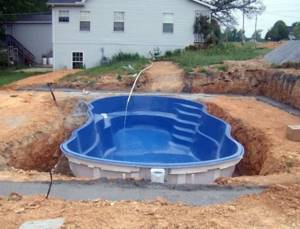
Attention! Designing a permanent swimming pool at your dacha requires the presence of additional communication systems. The required minimum is to organize a water supply, provide a cleaning system and further drainage of liquid. Neglecting the conditions will lead to rapid stagnation of water, its blooming and other problems.
The decision to design a swimming pool with a roof or canopy is practical. Such protection will reduce the clogging of water with debris and dust, especially if long breaks in use are planned.
When choosing material for a stationary model for your dacha, take into account the climate. Even in the absence of liquid, not all containers are able to maintain their integrity under the influence of severe frosts. Therefore, a thorough study of the characteristics of the material for a pool at the dacha is an integral condition for its further long-term operation.
Demonstrates the harmonious design of the pool at the dacha photo:
Collapsible
Setting up a collapsible swimming pool at your dacha is accompanied by lower material and labor costs. They usually offer models in small and medium sizes. Oversized structures are impractical due to the complexity of installation and dismantling.
A collapsible frame pool is ideal for an unguarded summer house. At the beginning of the season, it is collected and filled with water, and when constant coolness sets in, the liquid is disposed of, dismantled and stored in the utility room.
The design of a collapsible frame pool at the dacha is also not complete without installing treatment systems, but in terms of complexity they are much simpler than for stationary tanks. Typically, a treatment system requires medium-sized containers. If you set up a small artificial pond at your dacha, you can get by with periodically changing the water and using various reagents for disinfection.
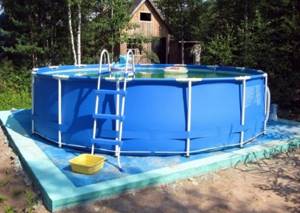
Inflatable
It’s easy enough to organize swimming at your dacha using an inflatable pool model. They are usually purchased for children's entertainment. There are many advantages to designing an inflatable tank:
- affordable price for the common man;
- quick installation and ease of assembly;
- does not require large free space;
- there is no need to install communications and purchase treatment systems;
- mobility and compactness.
Inflatable pools are represented not only by compact models. For your dacha, you can purchase a medium-sized tank, where older age groups have the opportunity to splash around. Typically, such products are supplemented with a frame made of aluminum tubes for stability.
Advice! If the height of the pool is above one meter, it is worth taking care of the design of the structure with a ladder. This will make the entry/exit process easier and prevent the sides from sagging. Otherwise, the integrity of the inflatable product may be compromised and the problem of water overflow may arise.
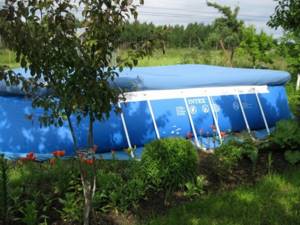
Concrete pool to order or do it yourself
Of course, this option is not feasible for everyone, and the cost will be decent, but there are craftsmen who managed to build a concrete pool with their own hands. So we decided to include it in our list of inexpensive ideas.
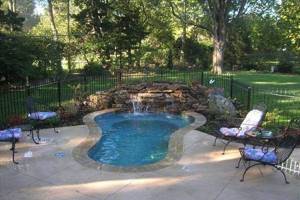
The most problematic aspect in this matter is digging a hole. You can only handle this on your own if you are planning to build a small and shallow pool. Renting a crane today is extremely expensive, and it is only advisable when creating a luxurious swimming pool, and not just for relaxing in the heat.
Unlike frame and inflatable pools, the concrete version is stationary, but at the same time one of the highest quality and most durable. To make such a pool with your own hands, you usually use a mixture of concrete and sand, which is sprayed onto a metal frame. The general procedure is as follows:
- Dig a hole for the pool. Its depth and width should be 23-31 cm greater than the expected dimensions of your pool. This distance will be filled by the form.
- Install water supply. Typically this will include a drain pipe that will be located at the bottom of the pool, as well as all the necessary structure (pipes, filters and pumps) to ensure a safe flow of water through the pool. It is acceptable to use PVC pipes with a strong binding material.
- Cover the walls and bottom of the pool with a steel frame, which will maintain its shape and strength over a long period of use.
- Spray the concrete and sand mixture onto the steel mesh using a powerful sprayer. The most popular mixture for building a pool today is Gunite (sprayed dry) or gunite (mixed with water). When applying, it is recommended to keep the sprayer nozzle at a distance of about 1 m from the steel mesh, direct the jet perpendicular to the surface and move it in a circular motion.
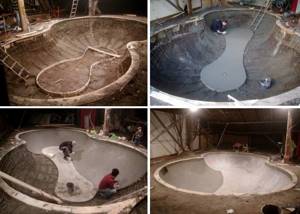
Then you just have to wait until the concrete hardens, after which you can begin decorating the walls of the pool with tiles or paint (optional).
Photos of finished projects on the topic of how to build a swimming pool with your own hands:
Also read: Inspiring verandas and terraces for the house (photo 2016)
Manufacturing materials
Decorating a swimming pool at your dacha is a multifaceted task. After determining the type of design, it is important to study the characteristics of the material from which the tank is made. Manufacturers usually offer three design options:
- polypropylene;
- plastic;
- composite material.
Tanks made of polypropylene have high technical characteristics. Excellent tolerance to low temperatures will allow you to design stationary pools with similar containers.
When decorating an artificial pond at a dacha, plastic is less practical. In the cold, the material becomes brittle and there is a risk of its destruction, so it is not suitable for large containers. Plastic decoration is more often used for folding structures and when installing decorative pools.
Decorating a dacha with models made of composite material is the most practical solution with the following advantages:
- The ability to take on any shape allows you to design a pool of various sizes and configurations.
- The walls of the container are made of composite material and are not subject to deformation and cannot be scratched.
- The strength of the material ensures long-term operation of the pool in the country.
Which option to choose depends on the planned costs, intensity and duration of operation.
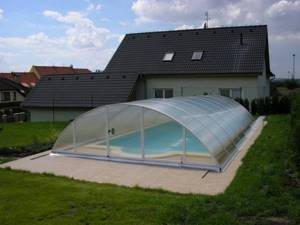
Filling level
The water level in a stationary pool depends on the type of structure, which can be:
- overflow;
- skimmer system.
In the first case, it is planned to design a grate around the perimeter of the tank, through which the splashed liquid is sent to the storage tank. Filling the bowl to the brim visually increases the size of the pool at the dacha.
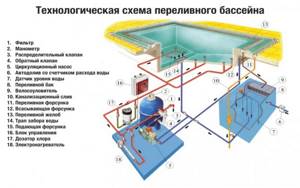
With a skimmer system, filling the container requires the presence of a minimum reserve within 15 cm from the top edge of the side. The absence of storage tanks does not allow water to be thoughtlessly splashed; it will not return back to the pool.

What are the benefits of having a roof over a swimming pool?
In order to decide to start building a pool under a roof, you need to understand what advantages it provides. Thanks to this overlap above the bowl:
- You can significantly extend the swimming season. Usually in northern latitudes at the end of September - beginning of October, the water in the pool cannot warm up on its own to a comfortable temperature. To extend the bathing season, it is usually heated. A roof over the pool will allow you to retain more heat, which will not escape into the environment, and, therefore, you can save energy resources for heating water. In this case, this design acts as a “greenhouse”.
- You won't have to clean the pool often. This will be especially true in the fall, when the leaves begin to fall. The roof will protect the pool from leaves, dirt, precipitation, and dust. This will significantly save money on water cleaning and purification, as well as on the purchase of filters.
- You can extend the life of the pool structure. Thanks to the “greenhouse”, the temperature inside is much higher than outside. The absence of extremely low temperatures will extend the life of the tiles, as well as the concrete base of the pool.
- Another positive effect is that ultraviolet radiation, passing through the pavilion ceiling, is refracted, thereby reducing its harmful effect on the structural elements of the pool bowl.
Finish options for stationary models
Finishing the pit of a stationary pool is carried out with various materials. For registration choose:
- PVC film;
- polypropylene;
- classic tiles;
- mosaic design.
PVC film is available in a wide color palette. To decorate a tank in a country house, the following shades are usually chosen:
- blue;
- turquoise;
- blue;
- white.
The material simultaneously combines two functions – waterproofing and decorative.
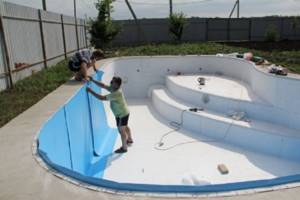
Polypropylene has excellent performance characteristics. Main advantages of the material:
- resistance to aggressive environments;
- high strength welding seams;
- durability.
As in the case of PVC film, when decorating a pool at the dacha, preference is given to blue-blue shades.
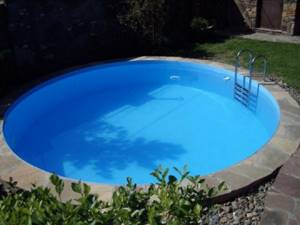
Attention! When choosing tiles or mosaics to decorate the surface of a stationary tank, preference is given to materials with low water absorption rates.
Finishing with ceramic tiles is usually carried out in public swimming pools; it is better to decorate containers for individual use with mosaics. Original overflows will provide a high degree of aesthetic design.
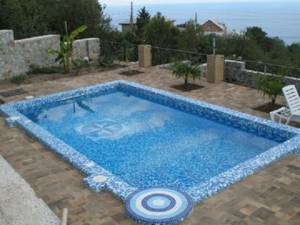
Selecting a location and determining dimensions
One of the key points of competent design of a swimming pool at a dacha is the choice of location, especially for stationary structures. The optimal conditions are the presence of clay soil. This is due to the ability of the soil to reduce water loss when the waterproofing layer is damaged.
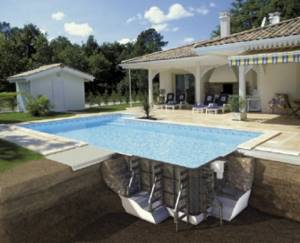
To ensure that the design and further maintenance of an artificial reservoir does not create unnecessary problems, it is worth considering a number of points:
- It is desirable that the area in the country house, which is allocated for the tank, have a natural slope. This will make it easier to design the drainage system at the dacha.
- The presence of trees near the pool is not recommended. Firstly, the shade from vegetation interferes with the process of warming up the water. Secondly, fallen leaves provoke excessive water pollution. Thirdly, the root system can damage the waterproofing design. The most aggressive representatives of the flora include poplar, chestnut and willow.
- After studying the wind rose, the pool at the dacha is positioned in such a way that the wind moves along the tank. This will allow debris to accumulate near one side and make it easier to clean.
- The presence of a water supply nearby will reduce construction costs and facilitate the process of filling the tank with water.
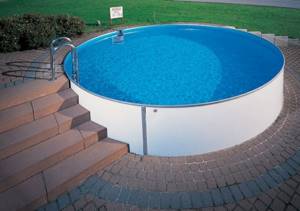
The shape of the pool at the dacha is selected depending on the purpose of the artificial reservoir. Serious swimming lessons require you to choose a rectangular design. It is better to organize children's fun in a round container. The extraordinary configuration of the bowl will help satisfy the desire to create an exquisite landscape design at the dacha.
The depth for adults varies between 1.5-2.3 meters. This will be enough for diving and ski jumping. Typically, the design of the maximum depth of the pool is carried out from one edge, where the tower is located. It is better to leave the entry point at a level of one and a half meters.
